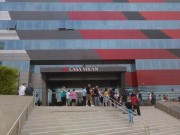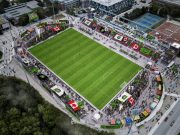It’s the equivalent to a new Jubilee organised every two and a half months for nine years, or an Expo that lasts a lot longer than the one in Milan. Following their analysis of the Tor di Valle project, Sapienza University of Rome prepared a substantial report which estimated the economic impact of Roma’s new stadium on the capital. In short, the university’s academics believe that the effects of the Giallorossi building a new home are “certainly positive” for the city: it will increase tax revenue, it will reduce unemployment and GDP will increase by €18.5 billion in nine years.
A lot more than just a stadium will be built at Tor di Valle, and it will have a financial impact not only for the Giallorossi on match days but far beyond the club for the city of Rome as well. The 50-page report’s initial results were revealed last week, but the figures confirmed today range from the project’s area to the positive effects it will provide once it has been completed.
€1.6 billion to be invested, and over 2/3 of the area will be eco-friendly
A total area of 180 hectares will be used for the project at Tor di Valle, and €1.6 billion – all from private investors – has been put on the table to bring the project to a successful conclusion. Some of this investment will be used to construct the stadium, business park and Convivium; €460 million (28.75%) will go towards completing the public works which, including the green spaces and infrastructure, will take up 78% of the 180 hectares. There are three structures, covering 38.5 hectares, which will be for private usage: the stadium (21), the business park (12.5) and the Convivium (5), which will contain shops and restaurants just a stone’s throw away from the stadium and Roma’s training ground. The rest of the 180 hectares has been designated for green spaces (62) and for infrastructure, such as roads, bridges, cycle paths, and the extension of the Metro B line up to the Tor di Valle station.

If work commences in 2017, the research team from Sapienza estimate that the funds will be spent over the course of six years: with 2022 as a deadline, the money will be split “with 2/3 being spent in the first three years and 1/3 in the last three years.” A total of €380 million – excluding technical costs, such as safety measures – will be spent on public works over the course of the first two years; the expropriation process will also finish in 2019 at a cost of €8.6 million, and the last tranche of investments will come in 2022 to take the total to €1.2 billion.
Impact on GDP, employment and the state, from tax revenue to transport
This injection of cash into the fabric of Rome will clearly help the city’s economy. According to the team of academics, if the project is completed it will result in cumulative GDP growth of €5.7 billion by 2019, €12.5 billion by 2022 and €18.5 billion by 2025. The alternative is the current situation, i.e. leaving the stadium unfinished, which would not only result in miss ing out on the estimated rise in GDP but also personal expenditure, which is predicted to increase by €2.4 billion over nine years.

The report adds that “as well as an increase in GDP, there is also a positive impact on employment rates and the public tax system.” According to La Sapienza’s calculations, employment will increase with the introduction of around 12,500 new jobs over the course of a decade, which will result in the “average reduction in the annual unemployment rate of around 0.8%”. Meanwhile the project’s direct impact will initially be through employing 1,500 people during the construction phase, and once everything is up and running around 4,000 people will be employed with another 15,000-20,000 working in the business park.
Among those who will benefit most from Roma’s new stadium is the state, who will bring in €460 million from the public works and additional tax revenue. This will be generated firstly by the works themselves and, further down the line, by the day to day activity across the entire complex. Tax revenue would increase by an average of €142 million per year for nine years, which they wouldn’t get if the Giallorossi continued to play at the Olimpico. The study reveals that, between 2017 and 2026, Tor di Valle would generate an increase of €1.4 billion in additional tax revenue while the city of Rome will benefit from an additional €30.4 million, with peaks of €4.1 million per year in 2022 and 2023.
It isn’t just about tax revenue though. The intention is to bring 50% of fans to the stadium by sustainable transport – by bicycle, on public transport or by car sharing – and in order to fulfil these ambitions for sustainability a number of additional factors have had to be taken into account. €460 million has been allocated to realise these ambitions: nearly €170 million for improving road access, junctions, bridges, and health and safety measures; €211 million will be spent on public transport and sustainable transport, including the extension of the Metro B line which will cost €54.6 million. That is nearly a third less than how much each Metro C station cost on average.







































